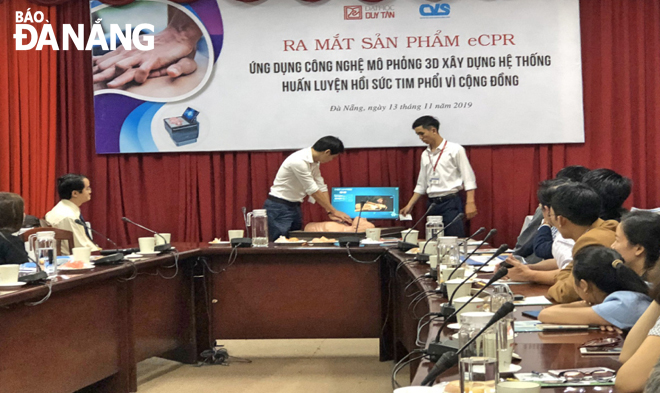Scientific product benefits the local community
The Virtual Reality Extracorporeal Cardiopulmonary Resuscitation Simulation (eCPR) system for first-aid training, created by the Duy Tan University (DTU), the largest private higher education school in Da Nang, has received high public praise for its high practicability and great usefulness. This system enables users to equip themselves with first aid skills so as to save victims in emergency incidents.
 |
| The DTU-created eCPR made its debut last month, receiving high praise from domestic experts |
Developed by the DTU Centre for Visualisation & Simulation (CVS), the system features a combination between 3D virtual reality with IoT (Internet of Things) technologies, using a model of the human body with built-in sensors.
The eCPR aims to teach first-aid and cardiopulmonary resuscitation skills to users of all age groups, especially about how to deal with such sudden and dangerous accidents that can lead to cardiac or pulmonary arrest, as a stroke, circulatory shutdown and drowning. The skills of necessitate emergency first-aid treatment on the spot before the victim is admitted to hospital.
The eCPR model’s hardware consists of a stand-alone CPR experimental booth, a plastic model of the human body, electronic circuitry, a personal computer and an appropriately designed multi-touch screen.
The software comprises a virtual reality 3D simulator, designed to process events in real-time and simulate the CPR sensations in the human hand and mouth, through IoT sensors.
In particular, eCPR offers 3 screen options- external chest compression only, external chest compression with mouth-to-mouth resuscitation and mouth-to-mouth resuscitation alone.
The system shows on a screen how to perform external chest compression and mouth-to-mouth resuscitation, and is based on analytic sensors which give a score while assessing and correcting the user.
The creation of this highly practical product is first initiated by the UTU’s Rector Le Nguyen Bao. During his previous overseas business trips, Bao found eCPRs located in public places to serve the community. He, therefore, hoped that similar products would be made in his hometown. However, in Viet Nam, such machines are only used in specialised medical aspects because of their high cost. Finally, he assigned the DTU Centre for Visualisation & Simulation to create a similar product benefiting the community.
According to Master Le Van Chung, the Centre’s Director, the statistics released by the World Health Organisation (WHO) in 2016 showed that, an estimated 17.9 million people worldwide died from Cardiovascular diseases (CVDs) in 2016, representing 31% of all global deaths, 92% of whom died before being taken to hospital due to no first aid with eCPR conducted. In addition, according to the renowned Viet Duc Hospital’s report, in Viet Nam, 50% of the victims receive no first aid or medical mistakes before being rush to hospital. There is no denying that, if wrongly applied, first-aid can make injuries worse or even kill the victim. Therefore, the DTU-created eCPR with specific guidance on cardiopulmonary resuscitation skills is a very useful product for the community.
Currently, the product is used to serve the purposes of learning of students at the DTU’s Faculty of Medicine.
In the coming time, more eCPRs are expected to be placed at such areas as traffic stations, schools, medical facilities, trade centres and amusement parks. Thereby, anyone, in an emergency, can play the role of a real doctor and rescue themselves and the lives of others.
By NGOC HA- Translated by ANH THU